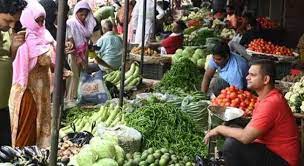“India’s Retail Inflation Hits 3-Month Low at 5.02% in September, Thanks to Plummeting Vegetable Prices”
India’s retail inflation rate for September has plummeted to 5.02%, attributed to a significant decrease in vegetable prices, coming well below economists’ predictions and aligning with the Reserve Bank of India’s projections. However, inflation remains a concern for the food segment, keeping the future outlook uncertain.


India’s headline retail inflation rate dipped to 5.02 percent in September, marking its lowest point in three months, primarily due to a substantial drop in vegetable prices. The data, released by the Ministry of Statistics and Programme Implementation, came as a surprise, as it significantly undercut economists’ expectations.
At 5.02 percent, the Consumer Price Index (CPI) inflation figure for September is 181 basis points lower than August’s 6.83 percent. This figure is also well below the forecasts of economists who anticipated a year-on-year price increase of 5.4 percent in September. The Reserve Bank of India (RBI) had earlier projected an inflation reading of 4.8-5 percent for the same month, which RBI Governor Shaktikanta Das later confirmed.
However, while headline inflation has returned to the RBI’s tolerance range of 2-6 percent, it has persisted above the medium-term target of 4 percent for four consecutive years.
The remarkable drop in CPI inflation during September can be attributed to the weakening of price momentum across various sectors. Notably, the Consumer Food Price Index fell 2.2 percent month-on-month, primarily due to a significant 15.8 percent sequential decline in vegetable prices. Consequently, food inflation fell to 6.56 percent from 9.94 percent in August. This decline was driven by the sharp decrease in tomato prices, which had previously propelled retail inflation to a 15-month high of 7.44 percent in July.
However, despite the overall drop in food prices, certain food items continued to exert upward pressure on inflation. For instance, cereals prices increased by 1.2 percent month-on-month in September, while pulses saw a 4.1 percent rise. Additionally, other sub-groups, including meat and fish, eggs, sugar, and spices, experienced price increases during the same period.
On the other hand, indices for ‘fuel and light’ and housing decreased by 3.9 percent and 0.1 percent, respectively, month-on-month. The miscellaneous category saw a minimal 0.2 percent increase, and clothing and footwear prices rose by 0.3 percent compared to August.
As a result, core CPI inflation declined to 4.5 percent in September, according to Moneycontrol’s calculations.
The September inflation figure aligns with the RBI’s earlier projection for July-September, providing relief to economists. Nevertheless, experts continue to emphasize the potential risks to the inflation outlook, particularly related to food prices. Challenges such as an uneven monsoon, delayed sowing of crucial crops like pulses and oilseeds, and modest reservoir levels raise concerns about food inflation.
Economists expect retail inflation to remain volatile within a wide range until June next year. However, despite these challenges, there is no anticipation of further monetary tightening from the RBI, which maintained interest rates in 2023-24 after a substantial increase in the policy repo rate during 2022-23. The central bank remains committed to its target of 4 percent, not merely within the wider 2-6 percent range, emphasizing the challenges ahead to achieve this goal.
Sources By Agencies




